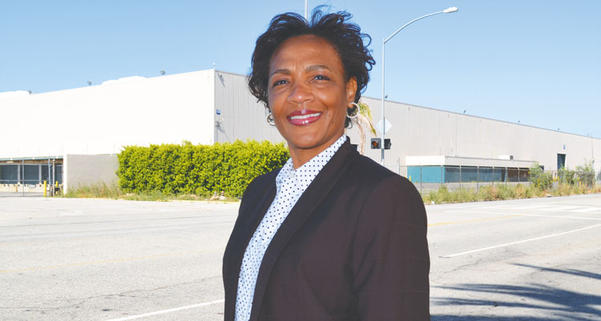With the end of Boeing’s C-17 Globemaster III manufacturing program in Long Beach in 2015, the city lost a significant source of employment as well as a major tenant for the Long Beach Airport. The City of Long Beach is about one-third of the way through the process of creating a specific plan for the site and surrounding commercial corridors with the goal of incentivizing additional investment and encouraging reuse of currently underutilized structures, according to Linda Tatum, director of Long Beach Development Services (LBDS).

Linda Tatum, the new director of Long Beach Development Services, said that the draft specific plan for the C-17 corridor should be released at a community meeting sometime in June. The corridor primarily includes light industrial areas surrounding the former manufacturing site for Boeing’s C-17 Globemaster III. (Photograph by the Business Journal’s Pat Flynn)
“It’s a planning process that is being built around the reuse of the former Boeing C-17 aircraft manufacturing properties, but we’ve expanded it along the Cherry Avenue corridor to pick up some other industrial and commercial properties that could benefit from some special attention,” Tatum explained. The rough boundaries of the area included in the new plan will be Carson Street to the north, Spring Street to the south, Redondo Avenue to the east and Orange Avenue to the west.
“We generally look for opportunity sites. Opportunity sites are areas where there are either vacant properties or properties that are underutilized, or are in need of potential reinvestment,” Tatum said of why certain areas were chosen to incorporate into the specific plan.
The purpose of creating a plan to guide land use in the area is to encourage the city’s desired development types under regulations that ensure a high-quality end result compatible with surrounding areas, according to Tatum. “This provides certainty for the development community in terms of knowing what the city’s aspirations are for those properties over the long term,” she said.
The first phase of creating the plan involved assessing existing conditions in the area, according to Tatum. LBDS staff conducted this work in-house with the assistance of an outside land use consulting team made up of planners, economists, urban designers and experts in infrastructure and traffic patterns.
The city has already held a number of meetings for community feedback on the future plan. “We went out to the community to say, ‘What are your preliminary thoughts about what kind of land uses, activities and amenities you would like to see?’” Tatum explained.
The city is entering the second phase of the document development process, which involves preparing a draft land use plan. Tatum said a draft will be revealed at a community meeting to be held in late June.
The third phase of the project will entail state and federal environmental review processes. The city is required to conduct an environmental impact report process under state law and must concurrently undergo a similar procedure for the federal government because federal funds were received for the initiative, according to Tatum. “That will be the third phase, and that will kick off I’m going to say at the end of the summer after we’ve refined a plan,” she said.
Tatum said the plan is likely to include zoning for “neo-industrial uses,” which are a mix of light industrial buildings, business parks, research facilities and other similar properties. “That will of course be very consistent with what’s already there,” she noted.
